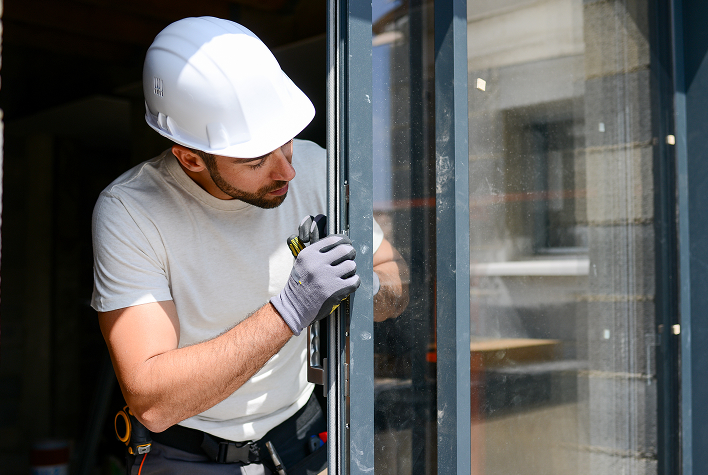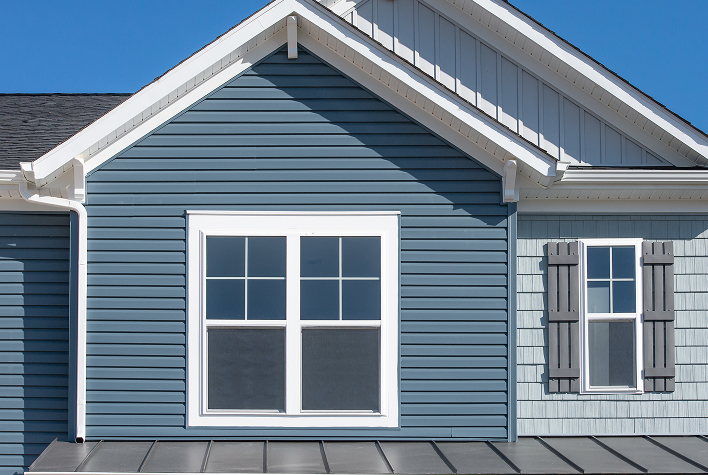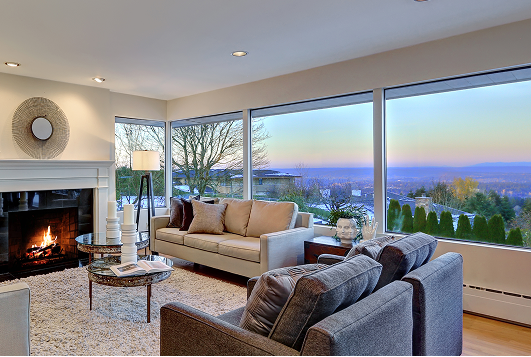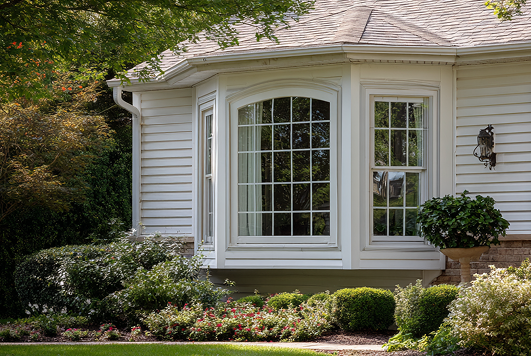
Key Points
- Vinyl replacement windows are durable, low-maintenance, and energy-efficient, helping reduce long-term utility costs.
- The total cost depends on factors such as size, glass type, window style, brand, and labor complexity.
- Vinyl is one of the most affordable and weather-resistant materials available for modern window replacements.
- Choosing energy-efficient glass and professional installation ensures comfort, performance, and warranty protection.
- Most homeowners spend between $8,250 and $33,000 for vinyl replacement window installation.
What are the Advantages and Disadvantages of Vinyl Windows?
Vinyl windows are a popular choice for homeowners due to their several advantages, but they also come with some disadvantages as mentioned below.
Vinyl Windows Pros
Vinyl Windows Cons
What Factors Influence the Vinyl Window Replacement Cost?

The replacement vinyl window prices vary widely depending on several factors, which we’ll go over one by one below.
Size
Larger windows need more materials and labor, which naturally increases the price. In some cases, installing larger vinyl windows may require extra steps like reinforcing the wall structure, leading to even higher labor costs.
- Vinyl Window SizePrice Range (Per Window)
- Small (2 ft x 2 ft)$200 - $500
- Average (3 ft x 4 ft)$300 - $800
- Large (6 ft x 6 ft or larger)$800 - $2,500
Types of Glass
The type of glass used in vinyl window replacement significantly influences the overall cost. Here’s how different glass options affect vinyl window pricing:
- Types of GlassEstimated Cost per Window
- Single-Pane Glass$200 - $900
- Double-Pane Glass$400 - $1,500
- Triple-Pane Glass$550 - $1,800
- Low-E Glass$450 - $1,250
- Laminated Glass$200 - $1,100
Single-Pane Glass
This is the most basic and affordable option, costing between $200 to $900 per window, but it’s also the least energy-efficient.
While it may save money upfront, single-pane windows are typically not recommended due to their poor insulation and soundproofing.
Double-Pane Glass
This option is popular for vinyl windows because it offers better insulation and noise reduction. It features two layers of glass with insulating gas in between, enhancing energy efficiency.
However, this improved performance comes at a higher price, typically ranging from $400 to $1,500.
Triple-Pane Glass
Triple-pane glass offers even better insulation and energy efficiency than double-pane windows, thanks to gases like argon or krypton between the layers.
Although it’s the most expensive option, costing around $550 to $1,800 per window, it provides the greatest energy savings and comfort.
Low-E Glass
This glass type features a special coating that reflects infrared light, helping to retain heat in the winter and keep it out in the summer.
Upgrading to Low-E glass can increase the initial cost, ranging from $450 to $1,250 per window, but it boosts energy efficiency and can lower heating and cooling expenses over time.
Laminated Glass
In areas prone to storms or high-impact conditions, laminated glass is a popular choice due to its durability.
While it costs more than standard glass, ranging from $200 to $1,100, it also provides added safety and soundproofing benefits.
Brand
The brand of vinyl windows affects replacement costs due to factors like reputation, quality, customization options, warranties, and installation requirements.
Premium brands typically come with higher upfront costs but often provide better durability, energy efficiency, and customer service, making the investment worthwhile over time.
According to Statista, Jeld-Wen was the most-used vinyl window brand among construction firms in the USA in 2014.
Here are the average costs per window for some of the popular vinyl window brands:
- BrandAverage Cost per Window
- Pella$500 - $2,800
- Andersen$400 - $2,300
- Jeld-Wen$300 - $2,200
- Milgard$350 - $2,300
- Marvin$600 - $1,900
Labor
The labor cost to install vinyl windows can range between $100 and $300 per window, depending on the job’s difficulty and location. This includes tasks like removing old windows, preparing the site, and installing new vinyl windows.
More complex installations, such as those involving custom windows or additional framing work, will naturally require more labor and thus increase the overall cost.
Window Type
When it comes to vinyl window replacements, various types of windows cater to different needs, styles, and budgets. These are some of the most popular window styles:
- Type of WindowEstimated Price per Window
- Single-Hung Window$300 - $800
- Double-Hung Window$400 - $1,200
- Casement Window$500 - $1,200
- Picture Window$400 - $800
- Bay Window$2,800 - $5,500
- Sliding Window$400 - $1,000
- Awning Window$400 - $1,200
Single-Hung Windows
Only the bottom sash (the part of the window that holds the glass) is movable, while the top sash remains fixed.
These windows are usually more affordable, costing between $300 and $800 each. However, they offer limited ventilation and are less energy-efficient than other styles.
Double-Hung Windows
Both the upper and lower sashes can move, providing better air circulation. These windows typically cost between $400 and $1,200 each. In addition to improved ventilation, they’re also easier to clean.
Casement Windows
Casement windows are hinged on the side and open outward like a door, operated by a crank. They typically cost between $500 and $1,200 per window.
The best thing about them is that they offer excellent ventilation and easily catch breezes. However, their mechanical parts can wear out over time and may need maintenance.
Picture Windows
Picture windows are large, fixed windows that don’t open and are meant to provide expansive views. They generally cost between $400 and $800 each.
These windows are excellent for letting in natural light and offering unobstructed views, but they don’t provide any ventilation since they can’t be opened.
Bay Windows
This type of window extends outward from the home, creating a small shelf or seating area inside. They typically cost between $2,800 and $5,500 each.
While they add space and architectural interest to a room, they can be pricey and more complicated to install.
Sliding Windows
Sliding windows move horizontally along a track and are usually more affordable, often costing between $400 and $1,000, which is less than casement windows.
They’re easy to operate and work well for wide openings, but they offer less ventilation compared to other styles.
Awning Windows
Awning windows are hinged at the top and open outward, often placed above or below other windows. They typically cost between $400 and $1,200 each.
These windows can be left open in the rain, making them a great option for bathrooms. However, they aren’t ideal for areas with high foot traffic outside the window.
Geographic Location
The cost of replacing vinyl windows can vary based on location due to differences in labor, materials, climate, and building codes.
In areas with higher living costs or harsh weather, prices may be higher, especially if you need energy-efficient or weatherproof windows. Local regulations might also require specific types of windows, affecting the overall cost.
The complexity of installation, particularly in older or historic homes, can also add to the expense. Generally, regions with a higher cost of living tend to have more expensive labor and materials compared to areas with a lower cost of living.
Window Location
Windows in hard-to-reach areas, such as upper floors or awkward corners, typically increase labor costs due to the added difficulty and time required for installation.
Additionally, windows in high-traffic or exposed areas, like front-facing or street-side windows, may require more durable materials or additional features, further raising the price.
Hidden Damage
Hidden damage like rot, mold, or structural problems found during vinyl window replacement can really drive up costs.
These issues often mean extra repairs are needed, such as replacing damaged frames, fixing leaks, or improving insulation, which all add to labor and material expenses.
If the damage is severe, a full-frame replacement might be necessary instead of a simpler retrofit, resulting in even higher costs.
What Are the Signs That Indicate Your Windows Might Need Replacing?
Signs that your windows might need replacing include:
Should You DIY or Hire a Professional to Replace Vinyl Windows?
Labor costs can account for about 15% of vinyl window replacement expenses, which might make DIY seem appealing. While doing it yourself can save some money upfront, it requires a solid understanding of window installation, including accurate measurements and proper weatherproofing.
Mistakes can lead to issues like poor insulation, water damage, or even voided warranties. Plus, DIY projects can be time-consuming, especially if you don’t have the right tools or experience.
On the flip side, hiring a professional ensures a proper installation, maintains energy efficiency, and preserves warranty coverage. Professionals bring expertise, manage complex installations, and save you time and potential stress.
While the upfront cost is higher, the long-term benefits, such as increased home value and reduced risk of errors, often outweigh the savings from DIY. That’s why we recommend hiring a pro for vinyl window replacements.
You can use a tool like HomeBuddy to find a local expert for window replacement. Just be sure to ask contractors questions about the project, check their online reviews, and get estimates from several companies to ensure you’re getting the best value.
What Are the Best Money-Saving Tips for Vinyl Windows?
To save money on vinyl window replacements, you can implement these tips:
Conclusion
The average cost of vinyl window replacement can range from $300 to $900 per window. However, what you end up paying can vary based on factors like the window type, brand, glass type, location, size, and labor costs.
While DIY installation might save you some money upfront, it’s generally a good idea to hire a professional. This not only ensures quality work but can also save you money in the long run by avoiding potential issues. A tool like HomeBuddy can help you quickly find a local expert for your window replacement needs.
Frequently Asked Questions
Are new home windows worth the investment?
Yes, new home windows can be worth the investment. They offer a return on investment (ROI) of 50%-70% by increasing energy efficiency, reducing utility bills, and boosting home resale value. They also boost the curb appeal, making your home more appealing to prospective buyers.
Is it more cost-effective to replace all the windows at the same time?
Yes, it is generally cheaper to replace all windows at once. This approach can lower overall costs due to bulk discounts, reduced labor expenses, and increased energy efficiency. Additionally, it ensures a consistent appearance and minimizes future disruptions, making it a cost-effective and convenient option.
What time of year is best to replace windows?
The best time to replace windows is typically in the spring or fall due to moderate temperatures, which allow for efficient installation and proper caulk adhesion. Spring is popular but can be more expensive due to high demand. Fall offers more flexibility and potential discounts, making it another good option.


